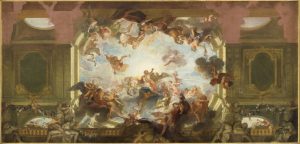
Antoine Coypel (French, ca. 1661 – 1722), Assembly of the Gods, 1702, Oil sketch on canvas, 37 3⁄8 x 76 3⁄4 in., Musée des Beaux‑Arts d’Angers, Angers, France, 38 J. 1881
© RMN-Grand Palais/Benoît Touchard/Mathieu Rabeau
NOMA hosts the once-in-a-lifetime exhibition The Orléans Collection through January 27, 2019, marking the first time in more than 200 years that works of art from the collection of Philippe II, Regent of France, have been reunited since their dispersal at auction in the 1790s.
After the death of his father in 1701, Philippe II assumed the title of Duke of Orléans, and became the owner of the Palais-Royal—an enormous palace in the center of Paris, built by Cardinal Richelieu in the mid-seventeenth-century.
Philippe II commissioned the painter Antoine Coypel, a member of the French Royal Academy of Painting and Sculpture, to paint the barrel-vaulted ceiling of a ceremonial space on the second floor of the Palais-Royal. This grand gallery was the triumphant culmination of an enfilade, a suite of rooms that would soon be filled with paintings from the Duke of Orléans’s collection.
In the summer of 1702, Coypel produced a large, loosely-painted oil sketch, plotting out the ceiling’s complex, multi-figured composition. The sketch has a grid structure underneath—a technique called “squaring,” which helped artists transfer smaller designs onto larger surfaces.
Coypel’s brilliantly-colored sketch features a trompe-l’oeil (fooling the eye) architectural structure that appears to have burst open, revealing an assembly of the gods in the heavens above. (This is a Roman Baroque design known as a quadratura). Coypel also incorporated several light-hearted details that are more typical of early eighteenth-century French painting, including the chubby putti (winged babies) draping floral garlands across the gilded ceiling.
At the center of the composition, mighty Jupiter, the king of the Gods, sits perched on a cloud. Below him, swathed in pink, Venus (goddess of love and beauty), asks Jupiter to intervene in the Trojan War on behalf of her mortal son, Aeneas. This scene comes from the Aeneid, an epic poem by the ancient Roman poet Virgil.
Assembly of the Gods, on loan to the New Orleans Museum of Art from the Musée des Beaux Arts d’Angers in France is the best record we have of Coypel’s work; the ceiling of the so-called Gallery of Aeneaswas destroyed by Philippe II’s descendents later in the eighteenth-century.
—Kelsey Brosnan, Curatorial Fellow for European Art
Read more about Antoine Coypel and his commissions for the Duke of Orléans in the catalog for the exhibition, for sale in NOMA’s Museum Shop or online.
Attend The Orléans Collection Symposium from January 11-12 where a series of speakers from the US and Europe will discuss The Orleans Collection and its lasting impact centuries following its auction and dispersal. Among the presenting scholars is Aaron Wilie, postdoctoral fellow at the University of Southern California, who will share his research on Coypel’s Aeneas Gallery